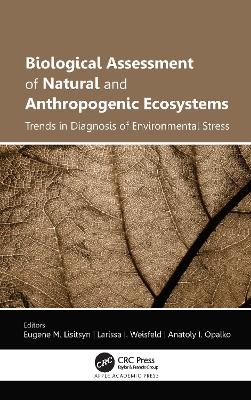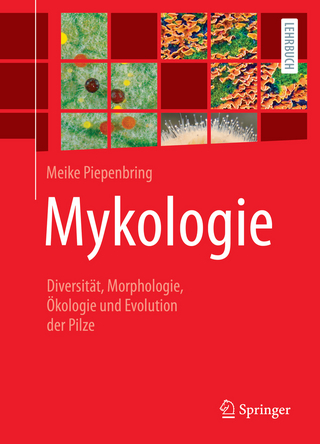
Biological Assessment of Natural and Anthropogenic Ecosystems
Apple Academic Press Inc. (Verlag)
978-1-77463-934-4 (ISBN)
- Lieferbar (Termin unbekannt)
- Versandkostenfrei innerhalb Deutschlands
- Auch auf Rechnung
- Verfügbarkeit in der Filiale vor Ort prüfen
- Artikel merken
This new volume, Biological Assessment of Natural and Anthropogenic Ecosystems: Trends in Diagnosis of Environmental Stress, diverse methods and achievements in assessing the biological state of ecosystems are presented, biochemical, genetic and cytological methods are used, methodological achievements in this area are discussed in this volume. Experimental and practical aspects of the genetic diversity of cultivated plants and its application in modern business conditions are considered. The use of biological indicators for the purpose of protecting nature and practical application is presented. The authors of the book are biologists, biochemists, genetics, and ecologists from prestigious scientific institutions.
This volume explores different types, different plant tissues and intracellular structures for the diagnosis and prediction of anthropogenic effects on living natural systems. Here, scientific information on the bioindication properties of living systems is presented and the theoretical foundations of its study are emphasized.
This authoritative reference source will be a valuable addition for scientific researchers and students working in the field of biology, ecology, genetics, cytogenetics, agronomy and environmental assessment and its protection from anthropogenic destruction. The authors highlight the achievements, problems, and opportunities of biological methods for indicating the environment.
Key features:
Provides an overview of recent events and opportunities in the field of bioindication to control anthropogenic damage of living systems
Considers the screening of new parameters to determine the health status of biological objects from one cell to an entire ecosystem, such as boreal peatlands
Presents the results of a study of the response of plants to abiotic stressors
Demonstrates the importance of role-related research of living objects as bioindicators
Provides new research on various topics of plant resistance to stress
Discusses design methodology, development and law of selection of indicators for specific environmental issues.
Eugene M. Lisitsyn, DSc (Biological Sciences), is Assistant Professor at the N.V. Rudnitsky North East Agricultural Research Institute, Russian Academy of Sciences in Kirov, Russia, and a Professor of Ecology and Zoology at Vyatka State Agricultural Academy, also in Kirov, Russia. He is a member of the N. I. Vavilov Society of Geneticists and Breeders. Dr. Lisitsyn is the author of over 230 publications in scientific journals and conference proceedings, as well as the co-breeder of oats variety Krechet. His research interests concern the basic problems of plant adaptation to environmental stressors, such as soil acidity, aluminum and heavy metals, and the other ecological problems. He has published chapters in several books, including Barley: Production, Cultivation and Uses; Biological Systems, Biodiversity, and Stability of Plant Communities; Chemical and Structure Modification of Polymers; Materials Chemistry: A Multidisciplinary Approach to Innovative Methods; Temperate Crop Science and Breeding: Ecological and Genetic Studies; and Antioxidants in Systems of Varying Complexity: Chemical, Biochemical and Biological Aspects, among others. Larissa I. Weisfeld, PhD, is Chief Specialist at the Emanuel Institute of Biochemical Physics of the Russian Academy of Sciences, Moscow, Russia; and a member of the All-Russia Vavilov Society of Geneticists and Breeders. She is also the author of more than 300 articles published in scientific journals and conference proceedings and holds seven patents for inventions. She is the co-author of four new winter wheat cultivars registered in the State Register of the Russian Federation. Her main field of interest concerns basic problems of chemical mutagenesis, mutational selection, and the mechanism of action of p-aminobenzoic acid. She has worked as a scientific editor in the publishing house Nauka ("Sciences" in Russian) (Moscow, Russia) and with the journals Genetics and Ontogenesis. She is the author of several book chapters and has co-edited several books with Apple Academic Press, including Ecological Consequences of Increasing Crop Productivity: Plant Breeding and Biotic Diversity; Biological Systems, Biodiversity, and Stability of Plant Communities; Temperate Crop Science and Breeding Ecological and Genetic Study; Heavy Metals and Other Pollutants in the Environment: Biological Aspects; Chemistry and Technology of Plant Substances: Chemical and Biochemical Aspects; Temperate Horticulture for Sustainable Development and Environment: Ecological Aspects, and Antioxidants in Systems of Varying Complexity. Anatoly Iv. Opalko, PhD in Agriculture, is a leading researcher and a professor at the Genetics, Plant Breeding and Reproductive Biology Division at the National Dendrological Park "Sofiyivka" of the National Academy of Sciences of Ukraine. He is also Head of the Cherkassy Regional Branch of the Vavilov Society of Geneticists and Breeders of Ukraine. He is a prolific author, researcher, and lecturer. He has received several awards for his work, including the badge of honor, "Excellence in Agricultural Education," and the badge of honor of the National Academy of Sciences of Ukraine "for professional achievement." He has also received the Nikolai Cholodny Prize in Botany and Plant Physiology. He is member of many professional organizations and is on the editorial boards of several Ukrainian and international biological and agricultural science journals. He is the author and co-editor of books with Apple Academic Press: Ecological Consequences of Increasing Crop Productivity: Plant Breeding and Biotic Diversity; Biological Systems, Biodiversity, and Stability of Plant Communities; and Temperate Crop Science and Breeding. He was also a reviewer and advisory board member for the book Heavy Metals and Other Pollutants in the Environment: Biological Aspects and Temperate Horticulture for Sustainable Development and Environment: Ecological Aspects.
PART I: Bioindication of Natural and Anthropogenic Ecosystems 1. Possibility of Using Cutover Peat Bogs in Bioindication of Environmental State 2. Paleopalinology Studies of Conditions of Peatlands Formation on European Northeast of Russia 3. Use of Artemia salina Biomarkers for the Evaluation of the Effect of Static Magnetic Fields PART II: Genetic Diversity: Experimental Induction and Evaluation of Ecosystems in the Modern Natural Environments 4. Theoretical and Applied Aspects of Mutations Induction for Improving Agricultural Plants 5. Enzymatic Activity of Bacteria Bacillus subtilis: Assessment Using Phosphemidum 6. Cytogenetic Characteristics of Seed Seedlings of Rhododendron ledebourii, Introduced in the Botanical Garden of Voronezh State University 7. Anthropogenic Pollution Influence on the Antioxidant Activity in Leaves and on the Cytogenic Structures in the Seedlings of the Representatives of the Rhododendron Genus 8. Cytogenetic Indices, Germination Ability, and Content of Total Protein in Seed Progeny of Betula pendula from Various Areas of Voronezh City with Different Levels of Anthropogenic Pressure PART III: Diagnosis of Environmental Status and the Adaptive Potential of Plants 9. Photoindication of Plant Nitrogen Nutrition 10. Revegetation and Launching Self-Restoration Process of the Disturbed Landscape Along the Transport Corridor in Western Siberia 11. Pigment Content in Plant Leaves as a Bio-Indicator of Adaptability to Growing Conditions 12. Some Indirect Methods for Predicting the Rooting Ability of Apple Tree (Malus spp) Stem Cuttings
| Erscheinungsdatum | 05.10.2021 |
|---|---|
| Zusatzinfo | 46 Tables, black and white; 6 Illustrations, color; 26 Illustrations, black and white |
| Verlagsort | Oakville |
| Sprache | englisch |
| Maße | 152 x 229 mm |
| Gewicht | 570 g |
| Themenwelt | Naturwissenschaften ► Biologie ► Botanik |
| Naturwissenschaften ► Biologie ► Ökologie / Naturschutz | |
| ISBN-10 | 1-77463-934-3 / 1774639343 |
| ISBN-13 | 978-1-77463-934-4 / 9781774639344 |
| Zustand | Neuware |
| Informationen gemäß Produktsicherheitsverordnung (GPSR) | |
| Haben Sie eine Frage zum Produkt? |
aus dem Bereich


